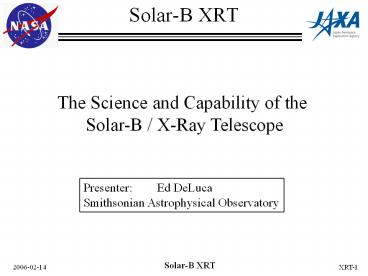Solar-B XRT - PowerPoint PPT Presentation
Title:
Solar-B XRT
Description:
Broadest temperature coverage of any coronal imager to date. ... Extremely large dynamic range to detect entire corona, from coronal holes to X-flares. ... – PowerPoint PPT presentation
Number of Views:15
Avg rating:3.0/5.0
Title: Solar-B XRT
1
Solar-B XRT
The Science and Capability of the Solar-B /
X-Ray Telescope
Presenter Ed DeLuca Smithsonian Astrophysical
Observatory
2
XRT Instrumentation
- X-Ray Telescope
- Mirror inner diameter 35 cm
- Focal Length 2700 cm
- Geometric Area 5 cm2
- Shutter/Analysis Filters
- texp 2ms to 10s
- 9 X-ray, 1 WL filter
- Camera
- 2K?2K back-illuminated CCD
- 1 arcsec pixels (13.5mm)
3
The XRT Firsts
New XRT Instrumental Capabilities
- Unprecedented combination of spatial resolution,
field of view, and image cadence. - Broadest temperature coverage of any coronal
imager to date. - High data rate for observing rapid changes in
topology and temperature structure. - Extremely large dynamic range to detect entire
corona, from coronal holes to X-flares. - Flare buffer, large onboard storage, and high
downlink rate provide unique observing capability.
4
Analysis Filter Set
5
XRT Science Goals
- Coronal Mass Ejections
- Coronal Heating
- Reconnection and Jets
- Flare Energetics
- Photospheric-Coronal Coupling
6
- Anticipated XRT Science Firsts
- Flares Coronal Mass Ejections.
- How are they triggered, and what is their
relation to the numerous small eruptions of
active region loops? - What is the relationship between large-scale
instabilities and the dynamics of the small-scale
magnetic field? - XRT will determine the topology, physical
parameters (T, ne), and interrelatedness of the
inner coronal regions integral to flare/CME
formation. - Coronal heating mechanisms.
- How do coronal loops brighten? TRACE has observed
loop oscillations associated with flares
(Nakariakov et al. 1999). Are other wave motions
visible? Are they correlated with heating? - Do loops heat from their footpoints upward, or
from a thin heating thread outward? Do loop-loop
interactions contribute to the heating? - XRT will exhibit the evolution and activity of
both active and quiet inner coronal structures
on MHD (seconds) to surface B diffusion (days)
timescales.
7
- Anticipated XRT Science Firsts
- Solar flare energetics.
- Although Solar-B will launch well before the next
solar maximum, there will still be many flare
events seen. The XRT is designed so that it can
test the reconnection hypothesis that has emerged
from the Yohkoh data analysis. - XRT will extend the sample of observed flares by
orders of magnitude in combined sensitivity,
spatial, and temporal resolution, allowing
stringent tests of flare theories. - Reconnection Coronal Dynamics.
- Yohkoh observations of giant arches, jets, kinked
and twisted flux tubes, and microflares imply
that reconnection plays a significant role in
coronal dynamics. With higher spatial resolution
and with improved temperature response, the XRT
will help clarify the role of reconnection in the
corona. - XRT will determine importance of flows,
B-fieldplasma interactions, relevance of null
points, reconnection sites, and separatrix (or
QSL) surfaces. - Photosphere/corona coupling.
- Can a direct connection be established between
events in the photosphere and a coronal response?
- To what extent is coronal fine structure
determined at the photosphere?
8
End Presentation































